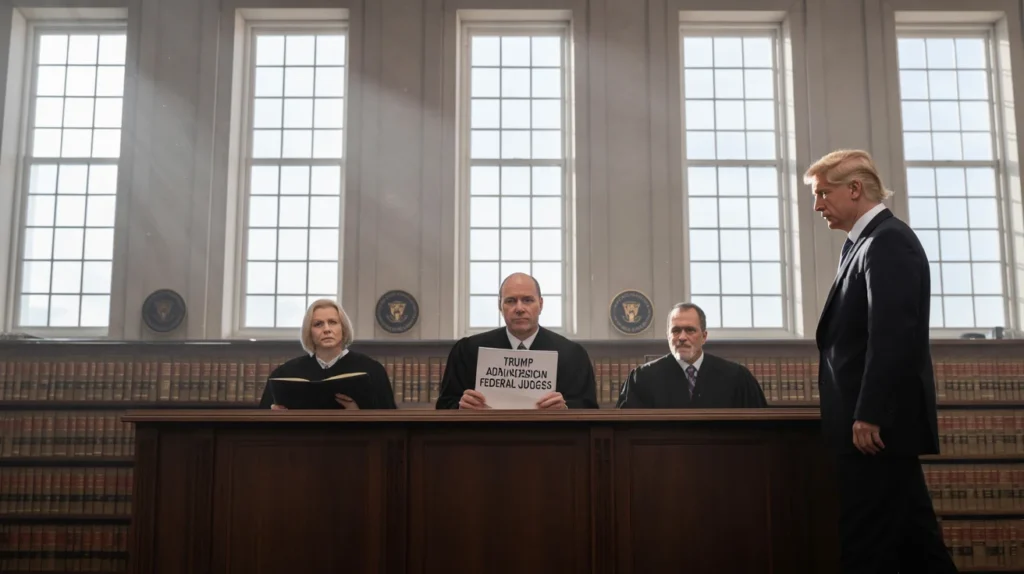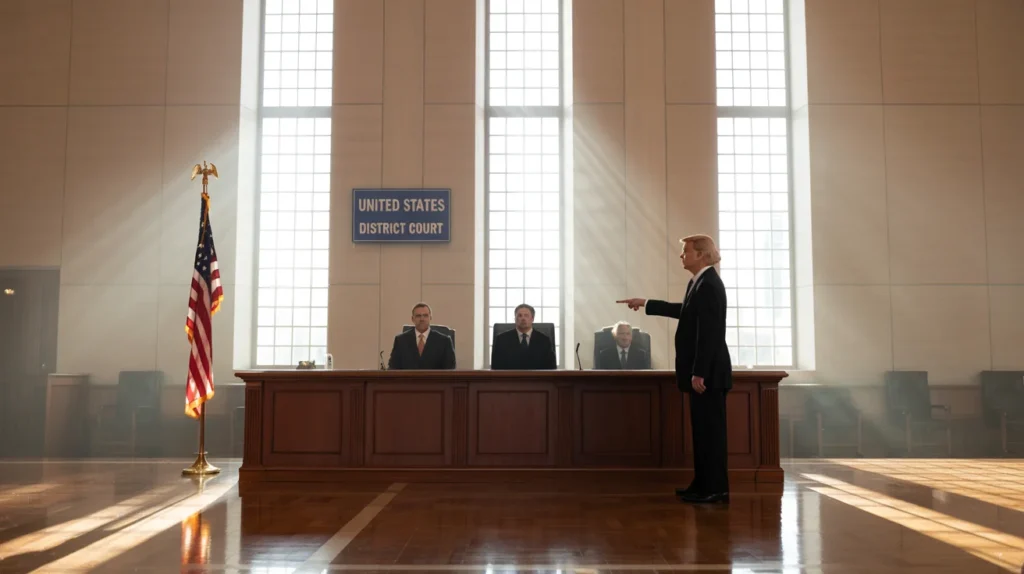In June 2025, the United States witnessed an extraordinary and unprecedented legal battle: the Trump administration sued all 15 federal judges in Maryland, along with the court clerk, over a standing judicial order that temporarily delayed deportations for detainees filing habeas corpus petitions.
The case, filed by the Department of Justice (DOJ) under Attorney General Pam Bondi, quickly became one of the most dramatic confrontations between the executive and judicial branches in modern American history.
The lawsuit marked an escalation of tensions between President Donald Trump’s administration and the judiciary, highlighting deeper conflicts over immigration enforcement, constitutional authority, and the separation of powers. While disputes between presidents and courts are not new, never before in U.S. history had a presidential administration directly targeted an entire federal bench.
This case is significant because it tests the very foundation of American governance: whether the executive branch can directly sue federal judges for judicial actions, and what this means for the balance of power that has held since the Constitution was ratified.
Background & Context
The Standing Order
On May 28, 2025, Chief Judge George L. Russell III of the U.S. District Court for Maryland issued a standing order. The order required that if a detained noncitizen filed a habeas corpus petition challenging the legality of their detention or deportation immigration authorities were prohibited from removing the individual until 4 p.m. on the second business day after the filing.
This rule was intended to safeguard due process. Detainees often file petitions at the last moment, and without a temporary hold, deportations could occur before judges have time to review the case. The order ensured that detainees had a fair chance to access legal counsel and for the court to examine claims before an irreversible deportation.
The Trump Administration’s Response
The DOJ immediately objected, calling the order an automatic injunction that interfered with immigration enforcement. The administration’s argument was straightforward: immigration laws passed by Congress give the executive branch authority to remove individuals without broad delays, and the Maryland judiciary’s blanket order disrupted that process.
Attorney General Pam Bondi argued that such judicial actions “infringe upon the constitutional role of the executive” and represent an attempt by unelected judges to dictate federal immigration policy. The DOJ further emphasized that there were existing legal avenues for detainees to seek relief and that a blanket order was unnecessary and unconstitutional.
Judges’ Perspective
Maryland’s judges defended their standing order as a routine docket management tool. They highlighted that similar measures already existed in other federal circuits. For example, the Fourth Circuit provides for automatic stays of deportation in habeas cases, and the First, Second, Third, and Ninth Circuits have comparable safeguards. These practices had never before prompted litigation from the federal government.
The judges argued that the order was not an attack on the executive branch but rather a modest measure to protect constitutional rights and prevent rushed deportations that could undermine justice.
Legal Aspects

The DOJ’s Legal Arguments
The Trump administration’s complaint rested on several key points:
- Exceeding Judicial Authority – The DOJ claimed that issuing an “automatic injunction” without a case-by-case review was beyond the court’s equitable powers.
- Violation of Separation of Powers – Immigration enforcement is an executive function, and judicial interference through blanket orders undermines the balance of power.
- Improper Remedy – The government argued that the correct way to challenge deportations is through individual petitions and appeals, not through a sweeping standing order.
Judicial Immunity
One of the strongest defenses for the Maryland judges was the principle of judicial immunity. Under U.S. law, judges are shielded from lawsuits for actions taken in their official capacity. This protection exists to preserve judicial independence and prevent intimidation by political actors. The judges argued that the DOJ’s lawsuit was invalid on its face because it targeted core judicial functions.
Historical Context
The lawsuit was unprecedented. While presidents from Nixon to Obama had serious clashes with courts, none had attempted to sue an entire federal bench. Historically, disputes between the executive and judiciary were resolved through appeals to higher courts, not through litigation against judges themselves.
This departure from tradition raised alarms among legal scholars, who warned that the suit threatened to erode one of the most important safeguards of democracy: an independent judiciary immune from political retaliation.
Political Impact
The Administration’s Broader Goals
The lawsuit reflected the Trump administration’s broader strategy to accelerate deportations and minimize judicial involvement in immigration cases. By suing judges directly, the administration sent a clear signal: it viewed judicial oversight not as a constitutional safeguard but as an obstacle to enforcement.
This aligned with other measures taken during Trump’s second term, including policies limiting asylum claims, restrictions on parole programs, and heightened rhetoric against “activist judges.”
Democratic Reactions
Democrats denounced the lawsuit as an attack on the judiciary. Maryland Governor Wes Moore described it as an “attempt to intimidate judges into silence.” Civil liberties groups warned that if the executive could sue judges, it would open the door to authoritarian abuse.
Republican Reactions
Reactions among Republicans were mixed. Some hardline immigration advocates supported the lawsuit, calling it a necessary step to “rein in activist courts.” However, several conservative legal scholars expressed concern that the lawsuit undermined long-standing principles of judicial independence.
Expert Legal Opinions
Legal experts across the political spectrum described the lawsuit as weak. Professor Daniel Pi argued that the case was less about legal victory and more about sending a chilling message to the judiciary. Former Solicitor General Paul Clement, who defended the judges, emphasized that the lawsuit had no legal merit and would almost certainly be dismissed.
Public Reaction
Media Coverage
Media coverage was polarized.
- Mainstream outlets (AP, Reuters, The Guardian, CBS) framed the lawsuit as a historic overreach, stressing its unprecedented nature and potential threat to judicial independence.
- Conservative outlets portrayed it as a bold attempt to stop unelected judges from obstructing immigration enforcement.
Social Media Trends
On social media, the lawsuit sparked heated debate. Supporters of Trump praised it as standing up to “activist judges,” while critics called it a “dictatorial move.” Legal Twitter and immigration lawyers widely mocked the DOJ’s arguments, predicting quick dismissal.
Public Sentiment
Polls suggested Americans were divided largely along partisan lines. Those prioritizing strong immigration enforcement tended to support the administration, while others feared the precedent of allowing presidents to litigate directly against judges.
Comparative Cases
Nixon and the Courts
During Watergate, President Richard Nixon defied judicial orders, but he never attempted to sue judges directly. Instead, the Supreme Court in U.S. v. Nixon (1974) forced him to hand over tapes, reinforcing judicial authority.
Obama and Immigration
President Barack Obama faced judicial roadblocks to his Deferred Action for Parents of Americans (DAPA) program. However, his administration pursued appeals through normal channels, respecting judicial independence despite political frustrations.
Why Trump’s Case Is Different
The Trump administration’s lawsuit goes beyond normal clashes. By targeting judges as defendants, it personalizes institutional conflict and seeks to delegitimize the judiciary itself. This shift represents a dangerous break from historical norms.
Constitutional Debate
Separation of Powers
At the heart of the dispute lies the question of the separation of powers. The Constitution divides government into three branches, each with checks and balances. The judiciary’s ability to review executive action is essential to this system.
If the executive can sue judges for their rulings, the independence of the judiciary collapses. Judges could fear retaliation for decisions, undermining their ability to serve as neutral arbiters.
Can the Executive Sue Judges?
Technically, the executive can file lawsuits, but judicial immunity ensures judges cannot be held liable for actions within their judicial role. Experts argue that allowing such lawsuits would make courts vulnerable to constant political pressure, destroying their neutrality.
Long-Term Democratic Risks
Legal scholars warn of three major dangers:
- Chilling Effect – Judges may hesitate to rule against the executive.
- Erosion of Norms – The long-standing respect for judicial independence may weaken.
- Authoritarian Precedent – Future administrations might target courts more aggressively, pushing the U.S. closer to democratic backsliding.
Future Outlook
Likely Legal Outcome
After all Maryland judges recused themselves, the case was therefore assigned to Judge Thomas Cullen, a Trump-appointed judge from Virginia. Moreover, early hearings suggested skepticism. In fact, Judge Cullen noted that judicial immunity would almost certainly apply. Consequently, observers widely expect the case to be dismissed by late 2025.
Political Implications
Regardless of the legal outcome, the lawsuit may shape political narratives. Trump’s supporters see it as proof of his willingness to fight “activist judges,” while opponents frame it as authoritarian overreach. The case is already being used in campaign rhetoric ahead of the 2028 election.
Broader Constitutional Impact
If dismissed, the lawsuit may strengthen judicial independence by reaffirming the doctrine of judicial immunity. If it were somehow to succeed, it would fundamentally alter the balance of power, empowering future presidents to pressure judges through litigation.
Conclusion
The Trump administration’s lawsuit against Maryland’s federal judges represents one of the most consequential executive-judicial confrontations in American history. Triggered by a modest order to delay deportations, the administration escalated the dispute into a direct institutional attack on the judiciary.
At its core, this case is about more than immigration it is about the balance of power in the United States. The Constitution established coequal branches to protect liberty and prevent tyranny. By suing judges for their rulings, the executive threatens that balance.
Whether dismissed swiftly or allowed to linger, the lawsuit will be remembered as a turning point in the relationship between the executive and judicial branches. Its legacy will shape debates about separation of powers, judicial independence, and the future of American democracy for decades to come.

